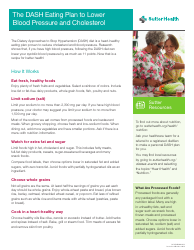High Cholesterol (Hyperlipidemia) Eating Plan - Continuing Medical Implementation
The High Cholesterol (Hyperlipidemia) Eating Plan - Continuing Medical Implementation is a dietary plan designed to help manage and control high cholesterol levels. It provides guidance on the types of foods to eat and avoid in order to promote heart health and reduce cholesterol levels.
FAQ
Q: What is high cholesterol?
A: High cholesterol refers to having too much cholesterol in your blood.
Q: What is hyperlipidemia?
A: Hyperlipidemia is a condition characterized by high levels of lipids (fats) in the blood.
Q: What is an eating plan for high cholesterol?
A: An eating plan for high cholesterol focuses on reducing intake of saturated fats and cholesterol while increasing intake of fruits, vegetables, whole grains, and lean proteins.
Q: Why is it important to follow an eating plan for high cholesterol?
A: Following an eating plan for high cholesterol can help lower cholesterol levels, reduce the risk of heart disease, and improve overall health.
Q: What foods should be avoided in a high cholesterol eating plan?
A: Foods to avoid in a high cholesterol eating plan include fatty meats, full-fat dairy products, fried foods, and foods high in trans fats.
Q: What foods should be included in a high cholesterol eating plan?
A: Foods to include in a high cholesterol eating plan include fruits, vegetables, whole grains, lean proteins, and low-fat dairy products.
Q: How can exercise help with high cholesterol?
A: Regular physical activity, such as aerobic exercise and strength training, can help lower cholesterol levels and improve heart health.
Q: Can medication be used to treat high cholesterol?
A: Yes, medication may be prescribed by a healthcare provider to help lower cholesterol levels if lifestyle changes alone are not sufficient.
Q: What are some lifestyle changes that can help lower cholesterol?
A: Lifestyle changes that can help lower cholesterol include maintaining a healthy weight, quitting smoking, limiting alcohol consumption, and managing stress.
Q: Is it possible to lower cholesterol through diet and exercise alone?
A: Yes, following a healthy eating plan and engaging in regular physical activity can significantly lower cholesterol levels without the need for medication in some cases.













